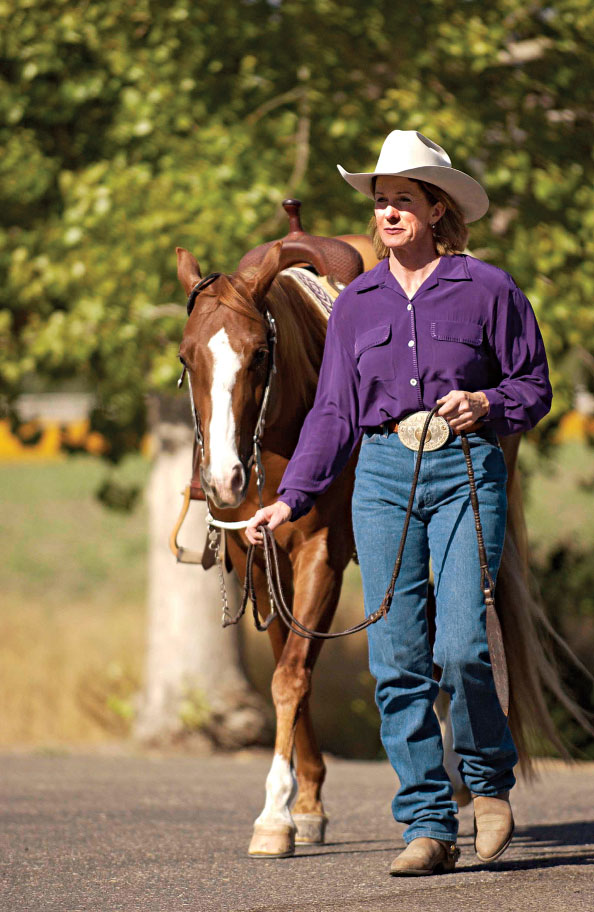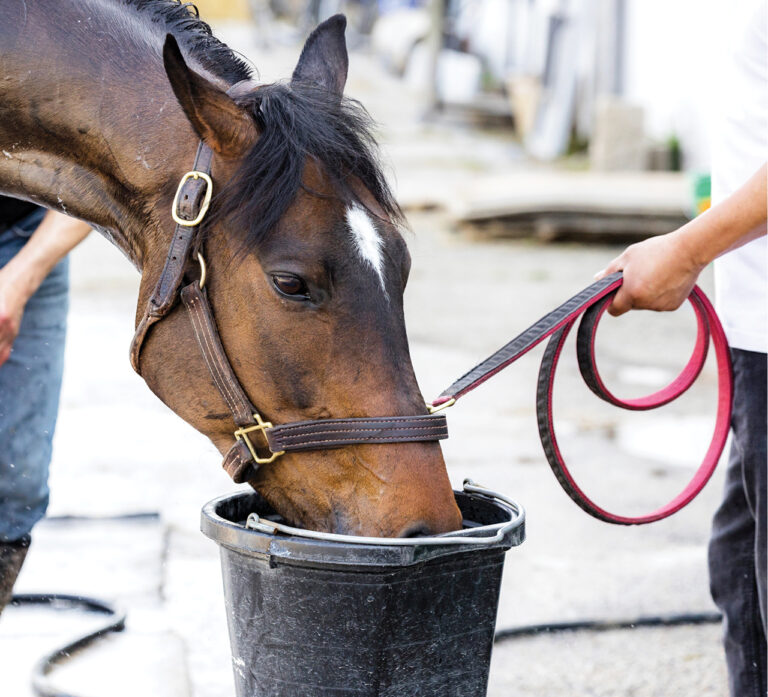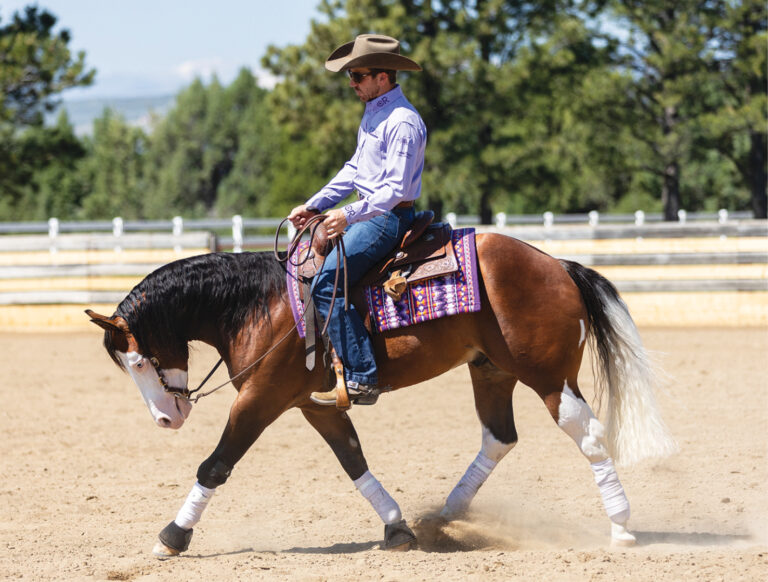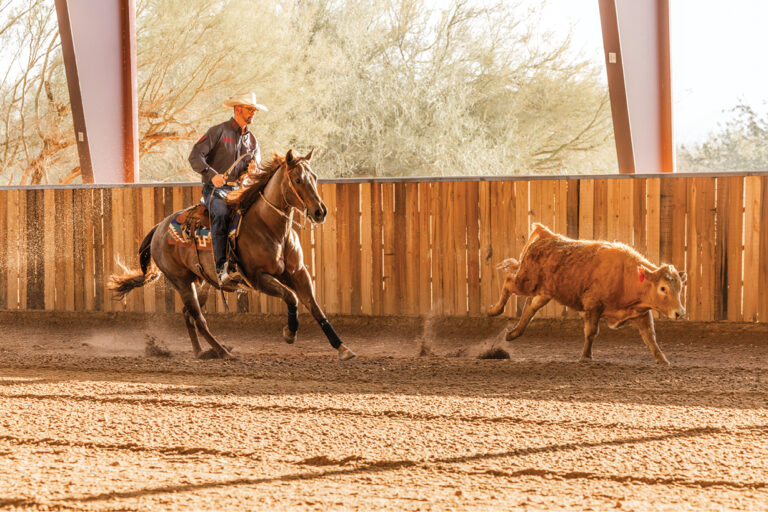
Training horses is not supposed to be mortal combat. We’re supposed to be using our much bigger human brains to make learning seem doable and non-threatening to our equine partners.
[READ: STOP BUGGING YOUR HORSE]
Knowing exactly how to do that, however, isn’t always obvious. I’ve spent the last 25 years figuring it all out. In particular, I’ve analyzed the basic philosophy of Tom and Bill Dorrance (making the right thing easy, the wrong thing difficult) to see how it applies to day-to-day training.
In this adaptation from my book, I’m going to share some key strategies with you. Whether you’re a rookie or well advanced in your horsemanship, these concepts will enable you to become a better rider—and wind up with a better-broke horse.
So, without further delay, here are the rules of thumb for “riding smart” that I’ve accumulated over the years:
Maximize every moment.
Whenever you’re with your horse, you’re either training or untraining him. If you’re picking out his feet and he’s leaning on you or dancing around, don’t let him get away with it—that’s setting an “I’m the boss” precedent in his mind.
Instead, take the time to set his priorities straight by insisting that he stand obediently when you need him to. If you’re riding him through a gate and he won’t move laterally off your leg, school him until he does. If you’re going down the trail on a pleasant morning and he’s pulling on the bit, don’t think, “Oh, it doesn’t matter now.” It does. All these random moments add up to a lot of good training; don’t waste them.
Set him up to succeed.
Your horse must understand and accept an idea before it can become his own, and only then can you train him how you want him to do what you’re asking. Another way to think of this is that you must show him until he understands and accepts a maneuver, and only then train him on it.
This means you must use your aids in a way that enables your horse to “find” what you want, rather than forcing him to do your bidding. Yes, hauling on the reins is one way to get a horse stopped. But how much better to lope him until he’s a bit tired, so that when you pick up your reins he wants to stop. Help him figure it out, and give him time to do so, then reward him when he does the right thing.
Once he’s figured out the what, only then can you start teaching him the how. Using our stopping example, that would mean getting his hind end up under him as he stops, staying off the bit, and so on.
This is so important! Think back to your school years…did you learn more from the teacher who rushed you, then bullied and humiliated you for a wrong answer? Or from the teacher who set you up to find the right answer, then told you how clever you were when you got it? If you help your horse—instead of hammer on him—when he’s confused, he’ll start to think of you as a friend he can look to for guidance when the going gets rough.
Be a contrarian.
This goes along with training every moment. If your horse is wanting to do one thing, make him do the opposite. Is he leaning in one direction? Make him go the other way. Is he amped up and wanting to lope? Make him stand still for a moment. Does he want to stand? Make him lope. Is he eager to be at the front of the line? Put him in the back.
In other words, don’t let him train you. If he’s a spook, don’t forsake trail rides—go on lots of them and get him exposed to all those frightening things. Don’t make excuses for him.
By insisting he do what you want rather than what he wants, you’re continuously reinforcing that you are the boss, not he. Horses crave leadership, and if you don’t provide it, they will.
Rule out physical pain.
You can’t train a horse that’s hurting, so whenever your horse is being stubbornly resistant, make sure it’s not because he’s in pain. Is he tossing his head? His teeth may need floating. Refusing to stop? His hocks may be sore. Resisting a turn? His suspensory ligaments (the structures supporting the back of the lower leg) may be sore. Always check with the appropriate expert—a veterinarian, chiropractor, or equine dentist—to rule out physical pain before pushing through in your training.
Train both sides.
Whether you know it or not, you own two horses, a right horse and a left horse, and they both need to be trained. Never assume something you’ve taught your horse to do using one side of his body will translate to the other; it won’t. You must train both sides individually.
If he can shut a gate working off your left leg, also teach him to do it off your right. Each side will likely require slightly different approaches, because most horses are a little stiff (resistant to bending) to the left and hollow (bend excessively) to the right—a function of their natural asymmetry. Ultimately, you’ll spend about the same amount of time working your horse to each side, striving to make his stiff side more flexible, and his hollow side more evenly (and not overly) bent.
Be precise.
A horse’s brain is like a computer, so the old “garbage in, garbage out” admonition applies. With a computer, if you enter a command that’s just one letter off, the computer won’t recognize and perform the command. Similarly, if you want optimal performance from your horse, you must ask for a movement exactly the same way each time.
Sometimes we get frustrated with a horse that’s not responding correctly. We think, “You dummy—you did it fine yesterday.” But our horse is thinking, “Yes, but you cued it differently today, so now I’m confused.” A fully trained horse is often able to fill in for a miscue, but while he’s still learning, the more precise and correct you can be, the faster and more reliably he’ll learn. Good stuff in, good stuff out.
Develop great timing.
Horses learn from the release of pressure, not the application of it. And when you release, your horse will associate that reward with whatever he was doing immediately before the release. So if you’re even a split second late releasing, you’re confusing your horse and slowing his learning, or even inadvertently “rewarding” something else entirely.
If you’re asking for a step backward, for example, the instant he even begins to think “back,” lighten the reins for an instant as a reward, then resume asking.
If you miss that moment, and instead lighten as he’s raising his head or opening his mouth, you’re rewarding him for what you don’t want. Timing is everything.
Be consistent and fair.
A cue can’t mean one thing half the time, and something different the other half—because you don’t enforce it. For example, “whoa” should mean stop—not slow down.
If you’re inconsistent in your followthrough, you oblige your horse to choose whether you really mean it each time you ask. That gives him only a 50/50 chance of doing the right thing. Inevitably, he’ll choose the easier, and in most cases, wrong thing and get himself in trouble. This inconsistency on your part is like lying to your horse, and you must be honest to gain his trust.
Similarly, you must never lose your temper. When you do need to make a correction, it must always fit the crime. Never suspect that your horse is trying to be bad on purpose—he isn’t. You probably confused him, so take that into consideration in your response.
A scared and intimidated horse isn’t going to try for you. But if he understands that you’ll always be fair with him, he’ll get confident enough to give his all. That said, don’t hesitate to “raise your voice” if that’s what’s needed.
[READ: OVERCOME FEAR AT THE LOPE]
Solve—don’t create—problems.
Any time your horse doesn’t respond the way you want, don’t compound the problem (or create a new one) by taking the wrong approach. Let’s say, for example, your horse is getting racy instead of staying in the steady lope that you’ve asked for. You really feel he should be “getting it” by now, but instead of losing your cool, you simply take all slack out of the reins, then draw him to a trot, then a walk, then a stop, then a backup— all in about six or so strides. Then you sit for a while and give him a chance to relax, then you try that lope again.
If, instead, you jerk him into the ground and scare him, then the next time he’s going fast, he’ll start worrying about getting jerked, and the problem will have been compounded.
In other words, when you do it the correct way, he thinks, “Oops, I’m racing along here…now she’s picking up the reins to break me down…I guess I’ll give her my face and come to her, because I know she’ll insist on that, but then at least I get to stop and rest.”
But the other way, he thinks, “Oops, she’s picking up the reins and she’s going to rip me a new set of lips…better brace my jaw and get my head up to protect myself.”
See how that works?
Be systematic.
Don’t try to teach your horse something you haven’t laid the foundation for. Also, don’t get into an argument you don’t have the tools to win.
Before you ask your horse to move laterally, for example, first be sure he understands the concepts of giving to bit pressure and moving away from pressure on his sides.
Go back to get ahead.
Start every schooling session by asking your horse for something he already knows well and is comfortable with. Then, after he’s shown you a few times how good he is, sneak another little bit of learning in there.
For example, go back to that good circle you were just walking before you ask for that little lateral step. Break all learning down into small bits, always returning to the last thing your horse did well (especially if he gets confused), then inching forward from there. This keeps him in a positive frame of mind for learning.
Be creative.
I usually try to teach my horses something a certain way, but if I’m not getting through by the third attempt, I take a different approach. In other words, I won’t force a horse to learn something “my way.”
Let’s say I’m asking for a transition from a large, fast circle to a smaller, slower one, and my horse won’t slow down. I can lope him until he wants to slow down, then reward that thought. This works with many horses, but if it doesn’t with the horse in question, I may try breaking him down to a trot, then to a walk, then to whoa and rest. I may also try pulling him into a much-smaller circle to slow him down. Or, as a last resort, I may draw him “into the ground,” then back him up to reinforce my point.
Ultimately, you must figure out what works for each horse, as each learns differently. Some trainers have a “my way or the highway” mentality. When a horse fails to respond, they say, “This horse doesn’t ‘fit’ me.” What they’re really saying is, “I’m not very creative.”
Ride the horse you’re riding.
This means that although you’re working from a plan, you’re also quick to change that plan depending on what your horse needs on any given day or in any given moment.
For example, if you’d planned to work on lead changes but, when you started warming up, your horse wouldn’t move off your leg, change your game plan and work on side-passing instead. Continue with that until your horse does become responsive to your leg, then resume your original plan.
Also, don’t expect your horse to be able to do something just because his dam or sire did it, or because you saw someone else doing it with a similarly bred horse. Concentrate on the unique individual that is your horse, and ride accordingly.
Be realistic in your expectations.
This applies both to your level of expertise and your horse’s ability and level of training. In other words, don’t try to do something you don’t know how to do, or that’s way above your horse’s level.
In determining what your horse is capable of, consider not only his current level of training, but also his breed, his conformation, his age, and his level of maturity.
Accept 1% improvement a day.
This doesn’t sound like a lot, but think of it: In 100 days, you’ve got 100% improvement. That’s significant progress, yet very doable.
Let’s say on one day your horse makes a little breakthrough in his walk-to-lope departure. You can ask him for that same level of performance a couple more times, to reinforce the learning, but don’t keep trying to improve it further on the same day. That way, your horse begins to think, “Hey—I’m quite a little loper!”
But if you keep after him to do even better than he just gave you, he begins to think, “I’m still not getting it! I must be a terrible loper.” He gets more and more anxious, and the gain you made disappears.
Accept that 1%, then ask for another 1% tomorrow.
View everything in proportion.
Don’t become fixated on any one part of your horse’s body, or any single exercise, or any specific training goal to the exclusion of everything else. For example, don’t put excessive importance on your horse’s head set at the expense of his ability to move laterally, or be collected, and so on.
Get outside input.
Ask a knowledgeable friend to watch what you’re doing and provide feedback. I’ve had friends say, “Why are you doing that?,” when I didn’t even realize I was doing it. Take lessons, go to clinics, and write down the feedback so you can work on it at home.
Watch videos of yourself schooling or showing. (And a word about those show videos: We tend to buy only the ones that show good performances, but the ones we most need to analyze are those showing weak ones. That’s where we need more work!)
Know when to get help.
Use the various forms of feedback you have to help you know when to turn to professional help. Everyone’s threshold for this is different. Obviously, if your horse is behaving in a way that scares you, or if what you’ve diligently tried is just not working, hire a trainer. You may need only a few corrective sessions to get back on track.
People tend to wait until problems have escalated, when they could have paid $30 or $40 and been straightened out in 45 minutes. As with your car, it’s better to get a tune-up regularly than to wait for the darn thing to break down before taking it to the shop.
It’s OK to work your horse.
Everything I’ve said about being fair and reasonable and flexible is true. But I don’t want you to get the impression that you can’t ask your horse for his best effort. People often feel guilty about pushing their horses, or about making them work when it’s cold or it’s feeding time or it’s late in the day or whatever. Don’t!
Think of it this way: What if you saw a help-wanted ad that said, “Job opening. Two square meals a day and a comfy room provided; housekeeping services included. Full medical benefits. Pedicure and new $125 shoes every six weeks. Applicant need work only one hour per day.” Wouldn’t you want that job? I sure would. So when you’re riding your horse in that one hour per day, don’t be afraid to ask him to work.
“A well-handled horse is a happy horse, and a happy horse progresses rapidly.” Sandy Collier’s training philosophy has brought her a lifetime of success in the performance horse world. Currently, she’s the only woman to have won the open division of the World Championship Snaffle Bit Futurity for reined cow horses (with Miss Rey Dry in 1993); she’s also an AQHA World Show champion (with Sheeza Shinette in junior working cow horse in 2002). The popular trainer and clinician is based in Buellton, California; find her new book, Reining Essentials and her training DVDs at sandycollier.com.




